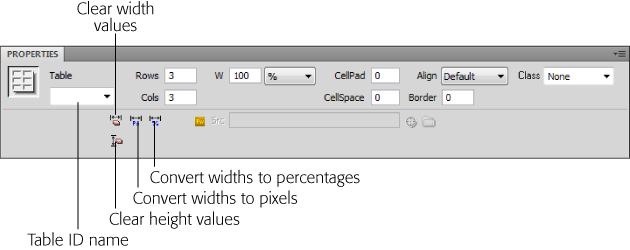Formatting Tables
When you first insert a table, you set the number of rows and columns, as well as the table’s cell padding, cell spacing, width, and borders. You’re not stuck, however, with the properties you first give the table; you can change any or all of these properties, and set a few additional ones, using the Property inspector.
When you select a table, the Property inspector changes to reflect that table’s settings (see Figure 7-5). You can adjust the table by entering different values for width, rows, columns, and so on in the appropriate fields.

Figure 7-5. When you select a table, you can do everything in the Property inspector, from adjusting its basic structure to fine-tuning its appearance. Dreamweaver includes two menus—Table on the far left and Class on the far right—which let you apply a CSS ID selector or a class style (page 112) to a table.
In addition, the Property inspector lets you set alignment options, and add colors or a background image, as described next.
Aligning Tables
In the normal flow of a web page, a table acts like a paragraph, header, or any other HTML block-level element. Browsers align it to the left of the page, with other elements placed either above or below it.
But you can make several useful changes to the way a table interacts with the text and other elements on a page. After selecting the table, use one of the three alignment options in the ...
Get Dreamweaver CS5: The Missing Manual now with the O’Reilly learning platform.
O’Reilly members experience books, live events, courses curated by job role, and more from O’Reilly and nearly 200 top publishers.

